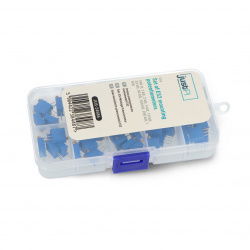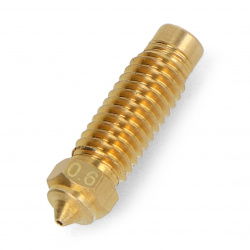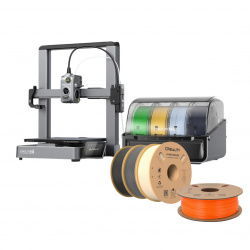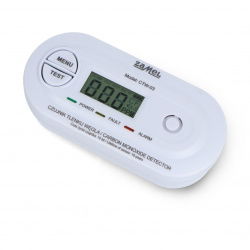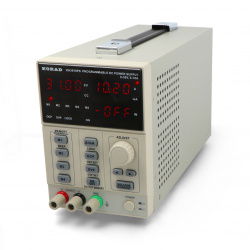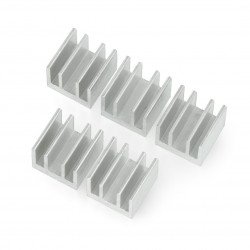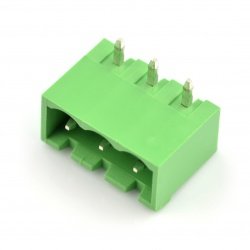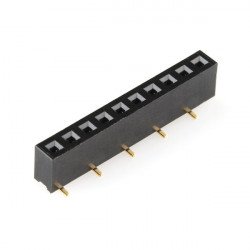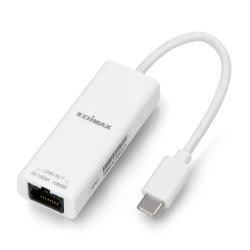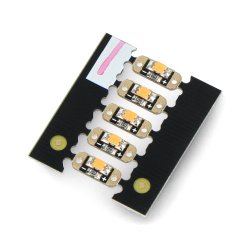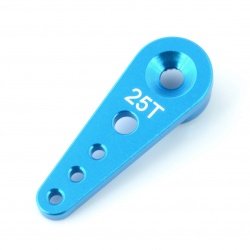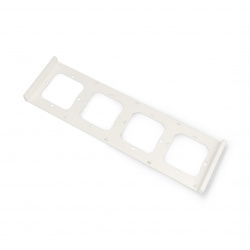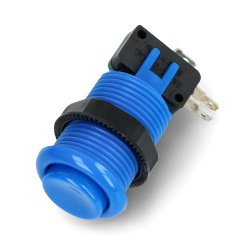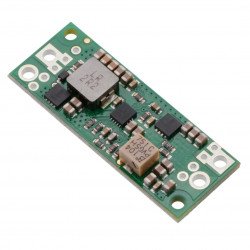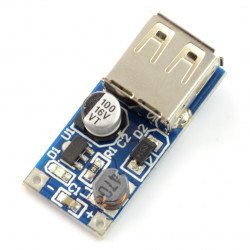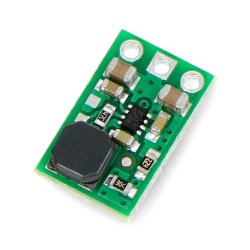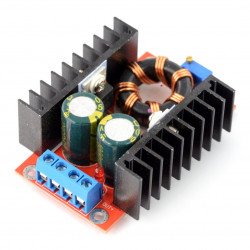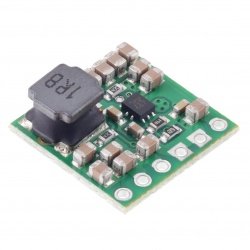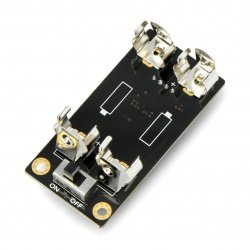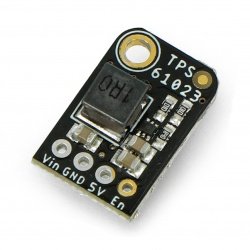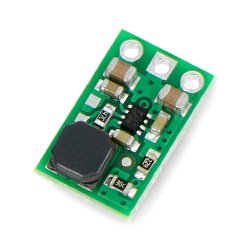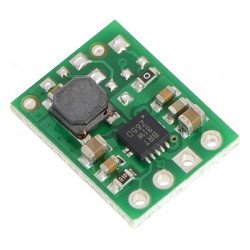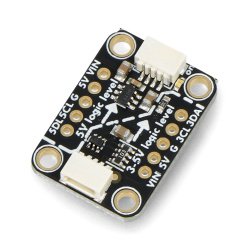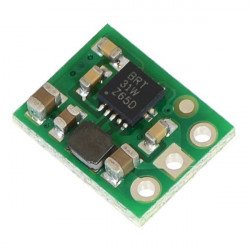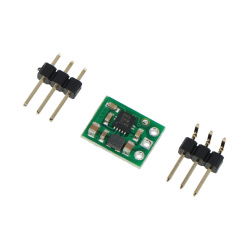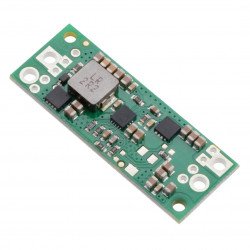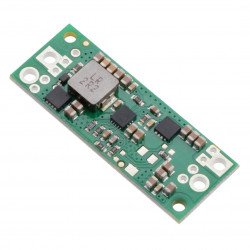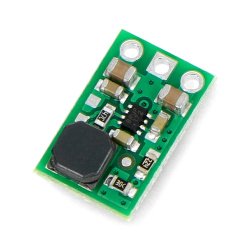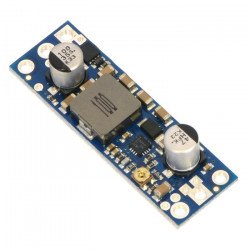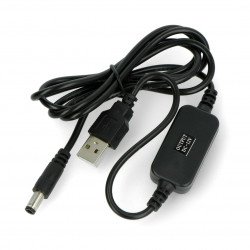The step-up converters (also known as a boost converters) is an power electronic converter, which is designed to increase the direct voltage (DC) from the source, receiving an appropriately increased DC voltage for the receivers at the output. The main purpose of devices such as DC-DC voltage converters, step-up and step-down converters is to power various types of electronics.
Converters step-up
Step-Up Voltage Regulator U3V7015 - adjustable- 4,5-20V 10A - Pololu 2890
Upgrade inverter with adjustable output voltage from 4.5 V to 20 V. The permissible input voltage range is 2.9 V to 20 V, and the maximum input current that the system can...Step-Up Voltage Regulator U3V16F5 - 5V 2A - Pololu 4941
Pololu step-up converter with an output voltage of 5 V and a capacity of 2 A. The supply voltage is from 1.3 V to 16 V. The minimum starting voltage is 2.7 V. Typical...Step-Up Voltage Regulator LM2577 - 5-56V 3A
Step-Up voltage converter based on LM2577 chip with input voltage from 3,5 V to 35 V DC. Output voltage adjustable by potentiometer from 5 V to 56 V. Current capacity is max. 3...Step-Up Voltage Regulator with USB socket 5V 1,2A
A step-up converter with 5 V output voltage and a maximum current of 1200 mA. It is powered from 2 V to 5 V. The output is a USB socket, so the chip can be used as a mobile...Step-Up Voltage Regulator U3V16F12 - 12V 2A - Pololu 4945
Pololu step-up converter with an output voltage of 12 V and a capacity of 2 A. The supply voltage is from 1.3 V to 16 V. The minimum starting voltage is 2.7 V. Typical...Step-Up Voltage Regulator 50W adjustable 12-35V/6A
Upgrade inverter with adjustable output voltage from 12 to 35 V. The permissible input voltage range is 10 V - 32 V and maximum power is 50 W .Step-Up Voltage Regulator U3V40F5 - 5V 4A - Pololu 4012
Pololu brand step-up converter with an output voltage of 5 V and a capacity of 4 A . The supply voltage ranges from 1.3 V to 5 V (the starting voltage is 2.7 V)....Step-Up Voltage Regulator U3V40F12 - 12V 3,5A - Pololu 4016
A step-up converter by Pololu with an output voltage of 12 V and a capacity of 3.5 A. The module is supplied with the voltage from 1.3 V to 12 V (the starting voltage is 2.7 V)....DFRobot Step-Up Voltage Regulator V3.0 with AA battery connector DFR0250 - 5V 1A
The system stabilizes the input voltage from 1.8 V to 4.5 V from two AA batteries (big sticks) to 5 V. The maximum output current is 1 A, module size is 65 x 33 mm.Step-Up Votage Regulator TPS61023 - Adafruit 4654
Boost type step-up converter with 5 V output voltage and 1 A current capacity. The input voltage should be between 0.5 V and 5.5 V . The minimum input voltage for start-up...Step-Up Voltage Regulator U3V16F6 - 6V 2A - Pololu 4942
Pololu step-up converter with an output voltage of 6 V and a capacity of 2 A. The supply voltage is from 1.3 V to 16 V. The minimum starting voltage is 2.7 V. Typical...Step-Up Voltage Regulator U1V11F3 - 3,3V 1,2A - Pololu 2561
A step-up converter with a 3.3 V output voltage. Maximum input current up to 1.2 A. Supply voltage in the range 0.5 V - 5.5 V. The system has a standby mode.Level Booster Breakout - 3V - 5V voltage level converter - STEMMA QT / Qwiic - Adafruit 5649
Level Booster Breakout is a board produced by Adafruit, it has the form of a voltage level converter that allows you to obtain an output voltage of 5 V from an input voltage...Step-Up Voltage Regulator U1V10F5 - 5V 1,2A - Pololu 2564
Step-up converter with 5 V output voltage. Maximum input current up to 1.2 A. Supply voltage in the range 0.5 V - 5.5 V.Step-Up Voltage Regulator U1V10F3 - 3,3V 1,2A - Pololu 2563
A step-up converter with a 3.3 V output voltage. Maximum input current up to 1.2 A. Supply voltage in the range 0.5 V - 5.5 V.Step-Up Voltage Regulator U3V70F15 - 15V 10A - Pololu 2896
Step-up converter with 15 V output voltage. Maximum current up to 10 A. Supply voltage from 2.9 V to 15 V.Step-Up Voltage Regulator U1V11F5 - 5V 1,2A - Pololu 2562
Step-up converter with 5 V output voltage. Maximum input current up to 1.2 A. Supply voltage in the range 0.5 V - 5.5 V. The system has a standby mode.Step-Up Voltage Regulator U3V70F12 - 12V 10A - Pololu 2895
Step-up converter with 12 V output voltage. Maximum current up to 10 A. Supply voltage from 2.9 V to 12 V.Step-Up Voltage Regulator U3V16F9 - 9V 2A - Pololu 4944
Pololu step-up converter with an output voltage of 9 V and a capacity of 2 A. The supply voltage is from 1.3 V to 16 V. The minimum starting voltage is 2.7 V. Typical...Step-Up Voltage Regulator U3V50AHV - 9-30V 5A - Pololu 2571
Upgrade inverter with adjustable output voltage of 9 - 30 V. The permissible input voltage range is 2.9 - 30 V and the maximum input current that the system can process is 5 A.Boost - Step-Up Voltage Regulator - DC 5,5/2,1mm plug - 5-12V 0,7A - Adafruit 2778
Cable with integrated converter step-up boost which provides output voltage of 12 Volts from a 5V supply received from the USB port. The output connector is a DC connector 5,5...Step-Up Voltage Regulator U3V16F3 - 3,3V 2A - Pololu 4940
Pololu step-up converter with an output voltage of 3.3 V and an efficiency of 2 A. The supply voltage is from 1.3 V (starting 2.7 V) . The minimum voltage needed for...Pololu boost - adjustable 4-25V 2A inverter - Pololu 799
Converter with adjustable output voltage ranging between 4 and 25 V. The maximum current up to 2 A. the input Voltage is 1.5 V to 16 V.Step-Up Voltage Regulator Boost - 2,5-9,5V 2A - Pololu 791
Converter with adjustable output voltage from 2.5 V - 9 V. Maximum current up to 2A. Input voltage 1.5 V - 9.5 V.See also
How does a step-up converter work?
In the circuit of a typical step-up converter, a transistor key and a diode are used. When the switching transistor conducts, it closes the circuit through the coil and the power source, and the diode in the switching circuit turns on because the voltage at its cathode is higher than at its anode. The basic rule in step-up converters is that the coil operates by maintaining continuity of current due to changes in the magnetic field, and the voltage at the output is always higher than at the input. When the transistor conducts, the current flowing through the coil creates magnetic field energy. When the switching transistor stops conducting, the current flowing from the source through the coil disappears. The previously accumulated magnetic field energy is, in accordance with Faraday's law of induction, changed into a voltage summed with the source voltage, which powers the receiver through a diode and charges the voltage-maintaining capacitor connected in parallel. The keying transistor is controlled by a square wave signal with variable duty cycle (PWM) - the higher the duty cycle of the signal, the higher the voltage at the output of the step-up converter.
High-quality adjustable step-up converters
The U3V70X family of step-up converters from Polou are high-performance converters with synchronously switching regulators that require a minimum voltage of 2.9V. Immediately after switching on, the regulator limits the input current to 10.0A. The converters are equipped with overload, short-circuit and undervoltage protection, and the recommended maximum continuous output current is 6.0A. The output current is proportional to the ratio of the input voltage to the output voltage, which means that the output current decreases as the output voltage from the converter increases. Polou converters also have built-in protection against reverse polarity voltage, thus protecting the receivers. The built-in low power consumption function prevents unnecessary energy loss. The U3V70X family converters are available in a version with a rigid output voltage in variants from 5.0V to 15.0V and in a version with a precisely regulated output voltage in variants from 4.5V to 20.0V, using a 12-turn potentiometer.
Step up converters, also called power electronic converters, are devices that enable increasing the direct voltage (DC) from the source and obtaining at the output (step up converters) a voltage increased by a specific value. Step up converters are extremely important elements of switching power supplies. Selected converter models are equipped with systems that enable control of the output voltage within a specific range. This solution enables stable and safe power supply of power receivers with different supply voltage requirements.
The type, number and maximum power of current receivers depend strictly on the specific type of converter (specifically its current parameters and application). Low- and medium-power receivers can be connected to car converters powered by batteries (the exception is high-power converters powered by high-capacity batteries). Converters in the form of single-board systems allow the connection of current receivers whose voltage and current do not exceed the nominal parameters of the converter.
An unloaded converter connected to a power source consumes the so-called no-load current. The specific consumption value is strictly dependent on the model and electrical parameters of the converter. Low-power devices draw from several dozen to several hundred milliamps. In turn, high-power converters can draw up to several amperes.






























































































































































































































































































































